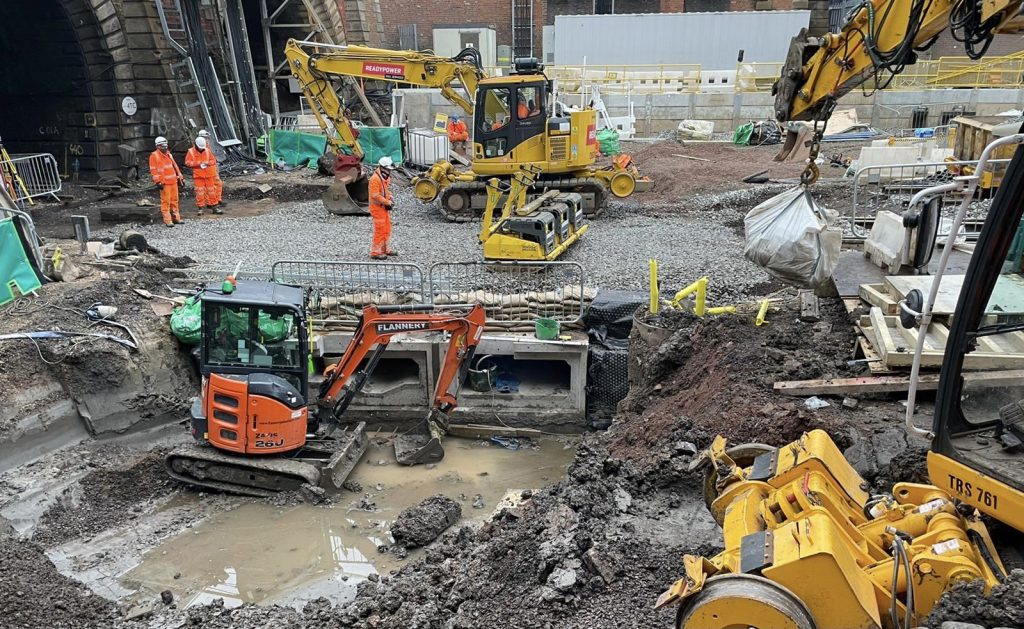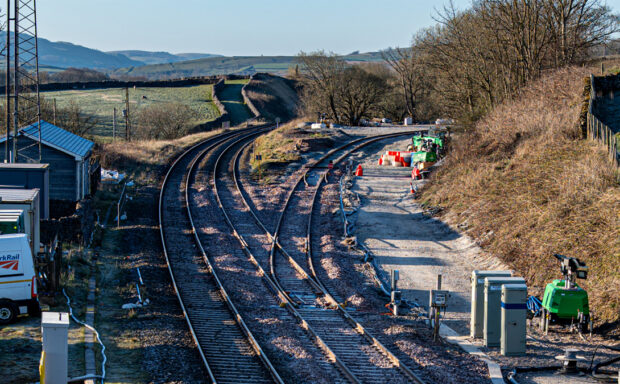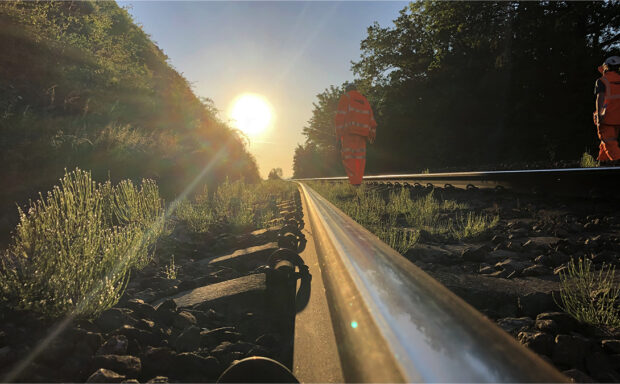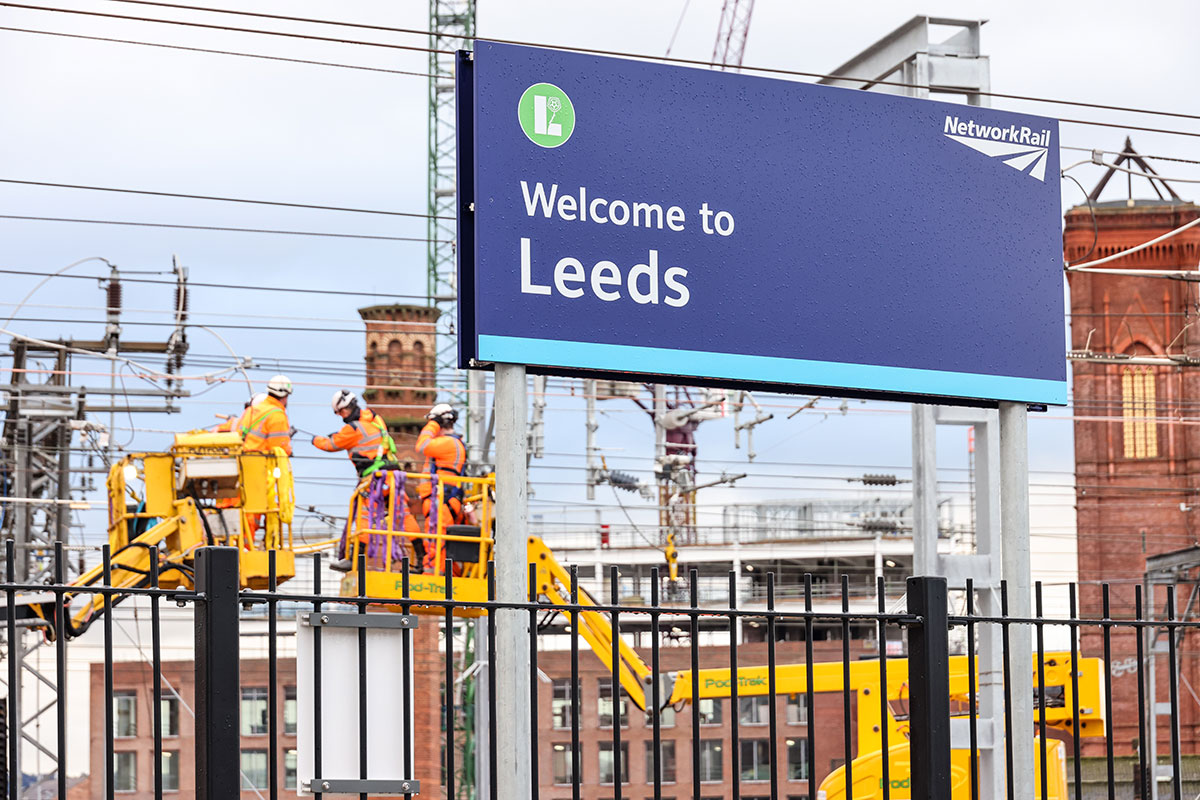It’s 11,000 tonnes, weighs more than the Eiffel Tower and is a first for UK engineering.
Last month we pushed this huge curved concrete box under one of Britain’s busiest railway lines, near Peterborough. Actually, we pushed this concrete box inside guide tunnels – at just 150cm an hour.
What for and why?
This exciting project is part of the £1.2bn East Coast Upgrade to allow more trains to run and deliver quicker journeys between London, the North of England and Scotland.
We spent nine days at Werrington, north of Peterborough, building a new tunnel so we could separate slower local services and freight trains from fast main line routes.
Watch this video to see our trial push:
Separating the lines is known as grade separation. It will enable slower moving freight trains to dive underneath the East Coast Main Line and use an adjacent line heading north. A bit like building a pedestrian underpass beneath a busy road so you can walk underneath the traffic instead of crossing it.
Building a tunnel underneath the East Coast Main Line in the traditional way wasn’t an option for us.
It wouldn’t have been possible to safely bore a tunnel large enough to fit two lines in and still keep the railway on top of it open to trains.
The East Coast Main Line is one of the country’s busiest lines, linking London with the North of England and Scotland. We would potentially have had to close it for over a month, instead of just nine days.
How did we do it?
Building this way was much less disruptive to train services, which were able to run while we had the tunnel cast in sections over a 10-month period next to the line.
In just nine days from 16 January, we removed the tracks of the East Coast Main Line, excavated the earth and pushed the tunnel into place.
We had two guide tunnels, which were circular and much smaller, allowing us to bore them with a traditional-style tunnel-boring machine. Meanwhile, the East Coast Main Line above remained open.
The sole purpose of these guide tunnels was to have a guide plate fitted within, each positioned at one of the bottom corners of the main tunnel.
We then used hydraulic jacks to push the 155 metres-long tunnel forward. We did 5.4 metres at a time, which took three to four hours per cycle.
Watch this how to video:
As we pushed in the main tunnel, we smashed open the tops of the two guide tunnels. This revealed the guide plates inside, which we used to slide the main tunnel into position.
We backfilled the tunnel and covered it back up, then replaced the tracks. What’s left of the guide tunnels is now buried forever beneath the main tunnel.
This method is rare and has only been done in the UK before with a straight tunnel. The curved tunnel is a huge achievement for our country’s engineering.
See the project from the air:
What else is happening as part of the East Coast Upgrade?
Once completed, the broader project will enable an extra two long-distance services an hour into and out of London. It will also improve train service reliability.
The area around London King’s Cross station is an important site for this upgrade.
The King’s Cross Remodelling project dramatically improve travel to and from London through a multi-million pound investment in renewing track, signalling (basically the traffic lights of the railway) and overhead line equipment (which powers electric trains) at King’s Cross.
This, combined with other East Coast Upgrade projects and the introduction of new trains on the route, will also help ease congestion and cut journey times.
Gallery: the Werrington guide tunnels and aerial views of the project near Peterborough
Track and overhead line equipment
We modernised the station itself in 2012 but much of the track and signalling equipment that serve it is more than 40 years old so it’s getting harder to maintain.
The work will simplify the layout of tracks leading to this iconic station, improving reliability by making it easier for trains to arrive and leave.
- We’ve replaced tracks in four of the platforms and installed new sets of points inside the tunnels outside the station. This will enable the complex tangle of track immediately outside the station to be simplified in two stages between March and the start of June.
- This has also required the installation of new overhead line masts to ensure they’re in the right place when we install the new track layout.
- We’re continuing to replace overhead wires and components, and install new ones, until the end of the remodelling project on 6 June.
Camden Sewer
Over Christmas, we completed our work to redesign and rebuild the Camden Sewer, which runs directly beneath the tracks outside the station. Trains had to run at a reduced speed over the Victorian sewer, which was very close to the surface.
We started work in Spring last year to rebuild the sewer at either side of the tracks and used a six-day closure of the station at Christmas to install a new, larger sewer and re-lay the tracks. Rebuilding the sewer means trains starting their journeys can accelerate earlier and more quickly.

Gasworks Tunnel
We’re also re-opening the third Gasworks Tunnel, which was closed in the 1970s, so that we can add two extra tracks on the approach to King’s Cross. This means more capacity and greater flexibility for services coming in and out of the station.
So far, we’ve excavated and re-laid solid foundations. We’ve also completed installing the tracks and signals into the tunnel. We’re using something called ‘slab track’ which doesn’t use ballast (the stones on the track bed); this has a much longer life span and doesn’t require as much maintenance, which is handy with a busy hard-to-reach tunnel.
We’re also currently installing the overhead line equipment in the tunnel and plan to reopen it to trains on 26 April.
Signalling
We’re modernising much of the signalling at King’s Cross. Meanwhile, we’re transferring the entiresignalling system between King’s Cross and Peterborough from the signal box at King’s Cross to the state-of-the-art Railway Operations Centre in York.
Modern signalling will help us recover services more quickly if disrupted. This change will also allow us to demolish the signal box at King’s Cross, creating more space for new tracks.
Read more:
The Werrington Grade Separation
From plot to platform: how fast can we build a railway station?



